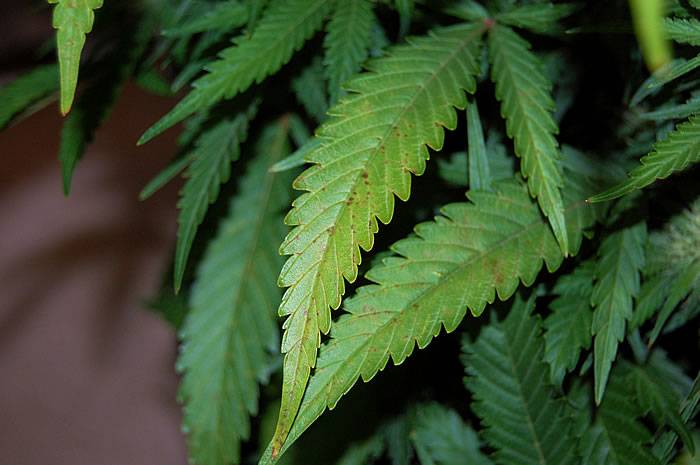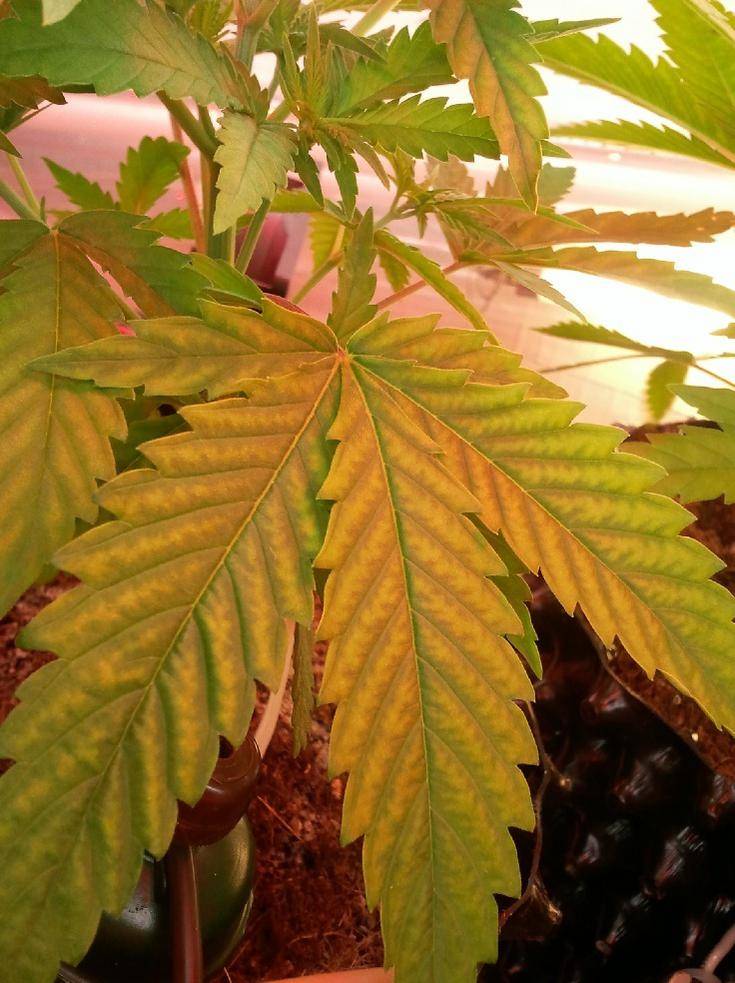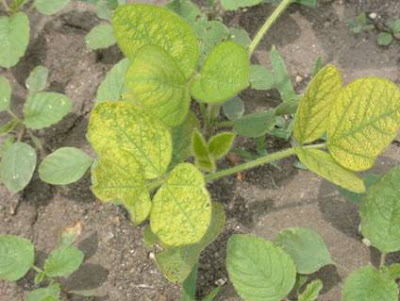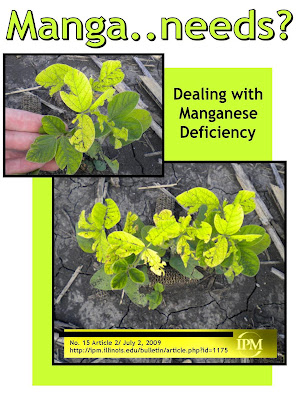I decided to make this guide based on stitches and the other nute def guides out there, all i wanted to do was make it more pic friendly, as i find the existing pics in the sick plants thread is outdated or does not give a wide enough array of what the problem could get to. i in no way am trying to take any credit from anyone including stitch, all im doing is "updating it" withh better pics and a bit more info. hope you ppl enjoy this as it took months of pic compiling and diagnosing and sorting blah blah blah and about 7 hours to compose....enjoy
Calcium deficiency
Calcium (Ca) deficiency is a plant disorder that can be caused by insufficient calcium in the growing medium, but is more frequently a product of low transpiration of the whole plant or more commonly the affected tissue. Plants are susceptible to such localized calcium deficiencies in low or non transpiring tissues because calcium is not transported in the phloem. This may be due to water shortages, which slow the transportation of calcium to the plant, or can be caused by excessive usage of potassium or nitrogen fertilizers.
Problems with Calcium being locked out by PH troubles
Very acidic soils with excessive potassium, dry and or wet soil. Lack of calcium in the soil may cause too acidic soil. This may cause to Mg or Iron deficiency or very slow stunted growth
Soil
Calcium gets locked out of soil growing at ph levels of 2.0- 6.4
Calcium is absorbed best in soil at a ph level of 6.5-9.1 (Wouldn’t recommend having a ph of over 7.0 in soil) anything out of the ranges listed will contribute to a
Calcium Deficiency.
Hydro and Soil less Mediums
Calcium gets locked out of Hydro and Soil less Mediums at ph levels of 2.0- 5.3
Calcium is absorbed best in Hydro and Soil less Mediums at ph levels of 5.4-5.8 (Wouldn’t recommend having a ph over 6.5 in hydro and soil less mediums.) Best range for hydro and soil less mediums is 5.0 to 6.0. Anything out of the ranges listed will contribute to a Calcium Deficiency.
Causes
Soils that are acidic, sandy, or coarse often contain less calcium. Uneven soil moisture and over use of fertilizers can also cause calcium deficiency. At times, even when there is a lot of calcium in the soil, the calcium can be in an insoluble form and is then unusable by the plant. Soils containing high phosphorus are particularly susceptible to creating insoluble forms of calcium.
This may be due to water shortages, which slow the transportation of calcium to the plant, or can be caused by excessive usage of potassium or nitrogen fertilizers.
Calcium deficiency symptoms appear initially as localized tissue necrosis leading to stunted plant growth, necrotic leaf margins on young leaves or curling of the leaves, and eventual death of terminal buds and root tips. Generally the new growth and rapidly growing tissues of the plant are affected first. The mature leaves are rarely if ever affected because calcium accumulates to high concentrations in older leaves.







Magnesium (Mg) deficiency
Magnesium (Mg) deficiency is a detrimental plant disorder that occurs most often in strongly acidic, light, sandy soils, where magnesium can be easily leached away. Magnesium is an essential macronutrient found from 0.2-0.4% dry matter and is necessary for normal plant growth.
Excess potassium, generally due to fertilizers, further aggravates the stress from the magnesium deficiency.
Magnesium has an important role in photosynthesis because it forms the central atom of chlorophyll.[1] Therefore, without sufficient amounts of magnesium, plants begin to degrade the chlorophyll in the old leaves. This causes the main symptom of magnesium deficiency, chlorosis, or yellowing between leaf veins, which stay green, giving the leaves a marbled appearance. Due to magnesium’s mobile nature, the plant will first break down chlorophyll in older leaves and transport the Mg to younger leaves which have greater photosynthetic needs. Therefore, the first sign of magnesium deficiency is the chlorosis of old leaves which progresses to the young leaves as the deficiency continues. Magnesium also is a necessary activator for many critical enzymes, including ribulosbiphosphate carboxylase (RuBisCO) and phosphoenolpyruvate carboxylase (PEP), both essential enzymes in carbon fixation. Thus low amounts of Mg lead to a decrease in photosynthetic and enzymatic activity within the plants. Magnesium is also crucial in stabilizing ribosome structures, hence, a lack of magnesium causes depolymerization of ribosomes leading to pre-mature aging of the plant. After prolonged magnesium deficiency, necrosis and dropping of older leaves occurs. Plants deficient in magnesium also produce smaller, woodier fruits.
Magnesium deficiency may be confused with zinc or chlorine deficiencies, viruses, or natural aging since all have similar symptoms. Adding Epsom salts (diluted to 8.5 oz. per 2.2 gal. of water) or crushed dolomitic limestone to the soil can rectify magnesium deficiencies. For a more organic solution, applying home-made compost mulch can prevent leaching during excessive rainfall and provide plants with sufficient amounts of nutrients, including magnesium.
Problems with Magnesium being locked out by PH troubles
Light Acid Soils, soils with excessive potassium, calcium and or phosphorus
Soil
Magnesium gets locked out of soil growing at ph levels of 2.0-6.4
Magnesium is absorbed best in soil at a ph level of 6.5-9.1 . (Wouldn’t recommend having a ph of over 7.0 in soil) anything out of the ranges listed will contribute to a Magnesium deficiency.
Hydro and Soil less Mediums
Magnesium gets locked out of Hydro and Soil less Mediums at ph levels of 2.0-5.7
Magnesium is absorbed best in Hydro and Soil less Mediums at ph levels of 5.8-9.1
(Wouldn’t recommend having a ph over 6.5 in hydro and soil less mediums.) Best range for hydro and soil less mediums is 5.0 to 6.0. Anything out of the ranges listed will contribute to a Magnesium deficiency








Calcium deficiency
Calcium (Ca) deficiency is a plant disorder that can be caused by insufficient calcium in the growing medium, but is more frequently a product of low transpiration of the whole plant or more commonly the affected tissue. Plants are susceptible to such localized calcium deficiencies in low or non transpiring tissues because calcium is not transported in the phloem. This may be due to water shortages, which slow the transportation of calcium to the plant, or can be caused by excessive usage of potassium or nitrogen fertilizers.
Problems with Calcium being locked out by PH troubles
Very acidic soils with excessive potassium, dry and or wet soil. Lack of calcium in the soil may cause too acidic soil. This may cause to Mg or Iron deficiency or very slow stunted growth
Soil
Calcium gets locked out of soil growing at ph levels of 2.0- 6.4
Calcium is absorbed best in soil at a ph level of 6.5-9.1 (Wouldn’t recommend having a ph of over 7.0 in soil) anything out of the ranges listed will contribute to a
Calcium Deficiency.
Hydro and Soil less Mediums
Calcium gets locked out of Hydro and Soil less Mediums at ph levels of 2.0- 5.3
Calcium is absorbed best in Hydro and Soil less Mediums at ph levels of 5.4-5.8 (Wouldn’t recommend having a ph over 6.5 in hydro and soil less mediums.) Best range for hydro and soil less mediums is 5.0 to 6.0. Anything out of the ranges listed will contribute to a Calcium Deficiency.
Causes
Soils that are acidic, sandy, or coarse often contain less calcium. Uneven soil moisture and over use of fertilizers can also cause calcium deficiency. At times, even when there is a lot of calcium in the soil, the calcium can be in an insoluble form and is then unusable by the plant. Soils containing high phosphorus are particularly susceptible to creating insoluble forms of calcium.
This may be due to water shortages, which slow the transportation of calcium to the plant, or can be caused by excessive usage of potassium or nitrogen fertilizers.
Calcium deficiency symptoms appear initially as localized tissue necrosis leading to stunted plant growth, necrotic leaf margins on young leaves or curling of the leaves, and eventual death of terminal buds and root tips. Generally the new growth and rapidly growing tissues of the plant are affected first. The mature leaves are rarely if ever affected because calcium accumulates to high concentrations in older leaves.
Magnesium (Mg) deficiency
Magnesium (Mg) deficiency is a detrimental plant disorder that occurs most often in strongly acidic, light, sandy soils, where magnesium can be easily leached away. Magnesium is an essential macronutrient found from 0.2-0.4% dry matter and is necessary for normal plant growth.
Excess potassium, generally due to fertilizers, further aggravates the stress from the magnesium deficiency.
Magnesium has an important role in photosynthesis because it forms the central atom of chlorophyll.[1] Therefore, without sufficient amounts of magnesium, plants begin to degrade the chlorophyll in the old leaves. This causes the main symptom of magnesium deficiency, chlorosis, or yellowing between leaf veins, which stay green, giving the leaves a marbled appearance. Due to magnesium’s mobile nature, the plant will first break down chlorophyll in older leaves and transport the Mg to younger leaves which have greater photosynthetic needs. Therefore, the first sign of magnesium deficiency is the chlorosis of old leaves which progresses to the young leaves as the deficiency continues. Magnesium also is a necessary activator for many critical enzymes, including ribulosbiphosphate carboxylase (RuBisCO) and phosphoenolpyruvate carboxylase (PEP), both essential enzymes in carbon fixation. Thus low amounts of Mg lead to a decrease in photosynthetic and enzymatic activity within the plants. Magnesium is also crucial in stabilizing ribosome structures, hence, a lack of magnesium causes depolymerization of ribosomes leading to pre-mature aging of the plant. After prolonged magnesium deficiency, necrosis and dropping of older leaves occurs. Plants deficient in magnesium also produce smaller, woodier fruits.
Magnesium deficiency may be confused with zinc or chlorine deficiencies, viruses, or natural aging since all have similar symptoms. Adding Epsom salts (diluted to 8.5 oz. per 2.2 gal. of water) or crushed dolomitic limestone to the soil can rectify magnesium deficiencies. For a more organic solution, applying home-made compost mulch can prevent leaching during excessive rainfall and provide plants with sufficient amounts of nutrients, including magnesium.
Problems with Magnesium being locked out by PH troubles
Light Acid Soils, soils with excessive potassium, calcium and or phosphorus
Soil
Magnesium gets locked out of soil growing at ph levels of 2.0-6.4
Magnesium is absorbed best in soil at a ph level of 6.5-9.1 . (Wouldn’t recommend having a ph of over 7.0 in soil) anything out of the ranges listed will contribute to a Magnesium deficiency.
Hydro and Soil less Mediums
Magnesium gets locked out of Hydro and Soil less Mediums at ph levels of 2.0-5.7
Magnesium is absorbed best in Hydro and Soil less Mediums at ph levels of 5.8-9.1
(Wouldn’t recommend having a ph over 6.5 in hydro and soil less mediums.) Best range for hydro and soil less mediums is 5.0 to 6.0. Anything out of the ranges listed will contribute to a Magnesium deficiency
Last edited:










